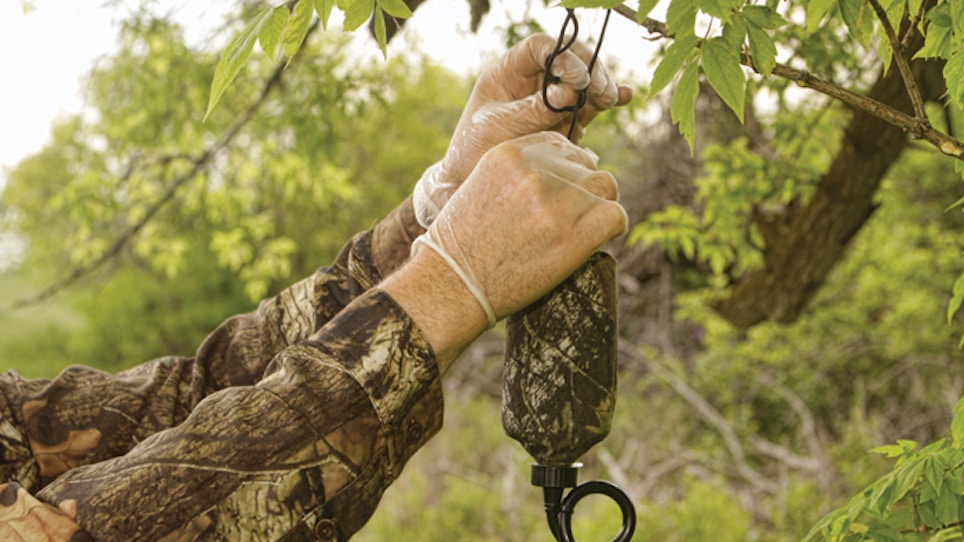It’s no secret whitetail bucks transform their behavior in the fall. In September, you’ll find bucks carousing in bachelor pods on every soybean field or stylized food plot. But when bucks strip their velvet, it’s as if a new critter is unveiled.
There are numerous reasons October bucks abandon an open September lifestyle and put on a vanishing act. Don’t worry – they’ll reappear during the action-packed month of the rut, but if you just bank on November, you’re hindering your chances to tag a mature buck. So what’s the answer? How do you boost your chances of skewering an October giant? Simple – you manipulate the phantoms of October. Here’s how.
Mock Scrape Perfection
Scrape sign can begin trickling in as early as late September, and then it explodes during the month of October. Bucks lay down scrapes to let other deer know they are in the area, and as breeding season unfolds, does use them to tell bucks they are ready for mating. Use these trailside signposts to lead you to an October ambush location.
Once you’ve located an active scrape line leading from a field edge into known bedding territory, set up your stand along the route in the place of your choosing and make the area even more desirable by creating a mock scrape.
First, scout carefully. You don’t want to push too far into the cover and bump deer. Move into a staging area where big bucks are likely to move before stepping out into their nightly grocery stand.
Next, look for a backdoor exit. You won’t be able to exit across the same field you entered from. Consider slipping out along a creek, gully or abandoned woodland road leading away from the main food source.
As you engage in mock scrape building, be extra considerate of your scent. Scent-containment clothing and latex gloves topped with a liberal dose of scent-eliminating products are a must. How big should you make your scrape? Scrapes vary in size just as the scraping bucks themselves do, but for the safe setup, make your scrape roughly the size of the others in the woods. Most are the size of a garbage can lid, and expanding that size slightly to attract attention certainly won’t detour interest.
Find a strong branch – three to four feet in length – and use it to scrape away the leafy buildup near the tree’s base. Scrape the material in the same direction a buck would if he were standing on the trail tossing the debris with his hoof. For attraction you can use a scent dripper to disseminate scent without having to revisit the area repeatedly. Scent wicks can also be doused or dunked and hung to accentuate scent for added airborne enticement. Now take up a watch and wait for a chance to intercept a sneaky October buck.
Make a Mock Rub
Whitetail bowhunting experts Barry and Gene Wensel were pioneers in the tactic of mock rubs, and whitetail fanatics Lee and Tiffany Lakosky also place rubs on their property to make a buck stop at an exact location. Take a cue from their frontier mentality and place a rub – or series of rubs – to lure bucks into a trap location.
First, determine what trees bucks like to rub on and if there is the possibility to harvest those trees to plant in your chosen spot. You won’t have that option on public land, but you may on private land. Be on the lookout for aromatic trees and those with soft bark. Both have been researched and attract bucks for rub attention.
Once you determine whether to get your future rubs from the forest or Home Depot, you’ll need a way to install them. In areas with soft dirt and abundant moisture, a hand-powered auger will suffice. In rocky or cement-hard soil you may need to employ a power or tractor-driven auger. If one post will do the trick, place it along the trail within shooting distance of your stand. If you want to alter travel, string the posts out in sight of one another. For stopping power, make the one in front of your stand more noticeable by putting in a larger-diameter pole. Now creep into hiding and let the October rubbing ensue.
Mock Trail Detours
There’s one last whitetail element you can mock with amazing October results. Mock a trail. Many of my whitetail manager friends routinely mow edges of fields to decrease vegetation for better visibility. Deer also walk those weed-free edges due to the path-of-least-resistance factor.
Like making mock scrapes or rubs, you’ll need to scout for trail construction areas away from field edges and farther back in the woods. Consider thick cover where bucks may linger after leaving a bedding area, possibly around an interior mast location such as a cluster of reliable, acorn-producing oaks. Trails that wind through briar thickets on their way to fields also rank high for path projects. Glades in woodlands, grassy hollows, dry wetlands and even tall cover crops all attract October travel when you add a manicured trail.
Schedule your intrusion for late summer or early fall using past knowledge of the area for routing efforts. This will give whitetails weeks to forget about the trimming disturbance and allow deer to settle into a pattern of using the new routes. You can also utilize your intrusion to put up treestands, establish mock scrapes and even add a rub or two for a complete mock package.






